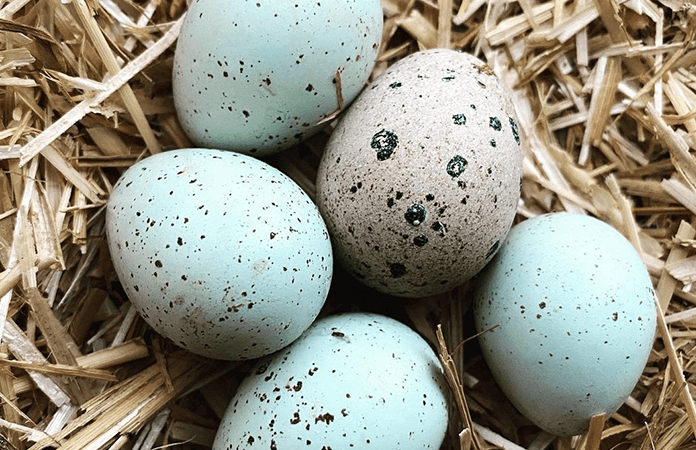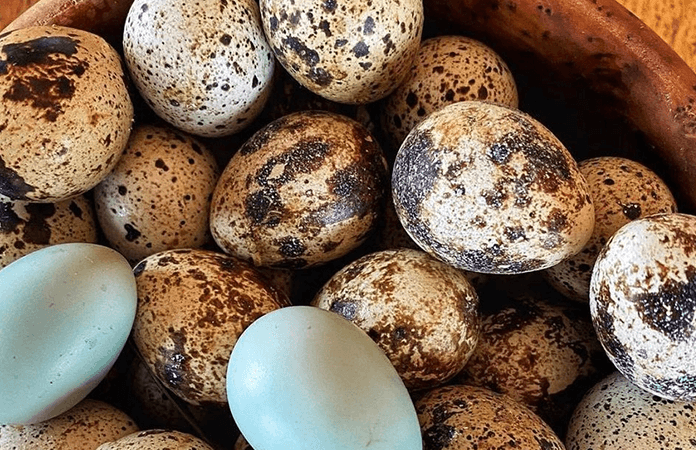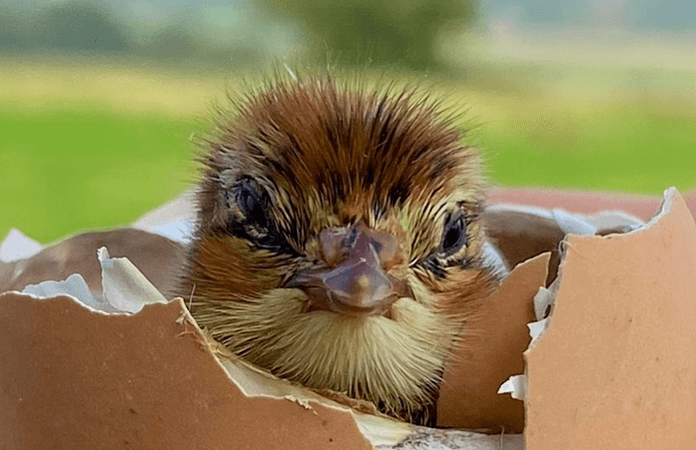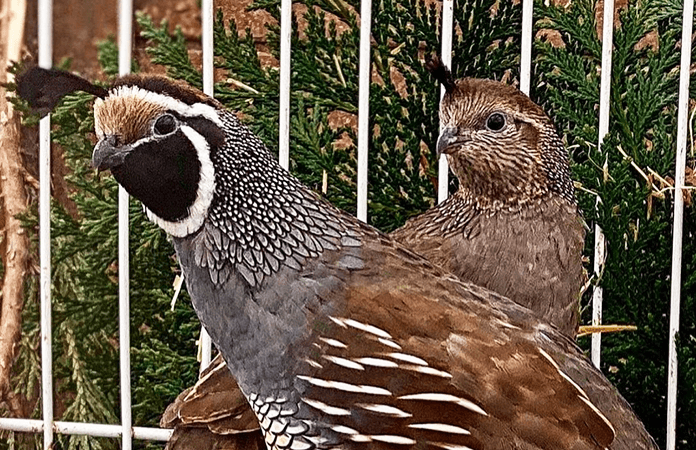Can Chickens Hatch Quail Eggs?

The answer is as simple as it is straightforward: Yes, broody chickens can hatch quail eggs. But there are some things to remember, as chickens and quails are not the same animals. We’ll guide you through the process to ensure you’ll hatch these quail eggs successfully.
6 Things to remember to successfully hatch and raise quail eggs using a surrogate mom chicken:
- Purchase quality fertilized quail eggs
- Choose the right chicken breed as a surrogate mom
- Let the hen do her job
- Keep a close eye once hatching starts
- Put the quail baby in a brooder
- Don’t house chickens and quails together
Hatching quail eggs with a chicken as a broody hen isn’t that hard, especially since the hen does most of the work. Quail eggs take a bit shorter to hatch than chicken eggs, about 17 days instead of 21 for chickens.
1. purchase quality fertilized quail eggs
Find yourself a reputable distributor of fertilized eggs. Look for small farms or homesteaders nearby; they often sell fertilized eggs to earn extra pocket money. By supporting local businesses, you’ll help small businesses to survive in a world of online mastodonts.
You can purchase fertilized quail eggs online if you can’t find local distributors. But be careful to read company reviews before placing the order. Or type their name into Google, and see what you find. If all seems right, you can set the order without having to fear online fraud.
2. Choose the right chicken breed
Quail eggs are tiny. Very tiny. They weigh approximately 3.5 oz (10 grams), depending on the type of quail egg. Obviously, you can not let a giant chicken breed sit on the quail eggs, as they will get crushed. Large chicken breeds like Orpingtons, Brahmas, or Australorps are not suited to hatch smaller-sized chicken eggs and are not the best breeds to use as surrogate moms for quail eggs.
Next to the largeness of the breed, there are chicken breeds that seldom go broody and therefore are incapable of sitting on eggs. Some breeds that are not good sitters are Polish chickens, White-Faced Black Spanish, Ancona, Leghorns, and many hybrid breeds, for example, a Green Queen.

But there are chicken breeds that are both broody and small-sized and, therefore, the best breed to keep in mind when hatching quail eggs using a chicken hen. Silkies are the broodiest chicken breed in the world; they’re often used to hatch other chickens’ eggs. And they’re also small in size, making them perfect for hatching quail eggs.
Bantam chickens are also a good choice, but be careful which bantam breed to choose, as some breeds are broodier than others. A Cochin bantam is a great brooder and sitter and an excellent option to hatch quail eggs. Although they’re relatively large bantams, they’re not as big as normal-sized chickens, and their weight is not a problem for quail eggs.
Ensure the nesting box bedding is soft and comfortable so the hen feels cozy and the eggs can’t crack. Preferably use nesting box pads instead of loose material as it can move and be kicked out of the nesting box.
3. Let the hen do her job
A mother knows best, is often said. Chicken moms-to-be follow their maternal instinct to sit on eggs. They only leave the nest shortly to eat, drink and take a bathroom break. Your fertilized eggs are in great hands! Don’t disturb her too often; it can cause stress to the hen, which can have a negative impact on her staying on the eggs. Don’t touch the hen or the eggs during sitting unless you suspect something is wrong.
That being said, not all broody chickens are good mothers! Some leave the nest after a few days or hurt the chicks after hatching.
If you’re using this chicken for brooding for the first time, check on her regularly. Keep an incubator closeby, just in case she leaves the eggs.
Once the chicks are almost ready to hatch, you can even hear them peeping inside the egg.
4. Keep a close eye once hatching starts
After 17 days, more or less, the baby quails are ready to hatch! This is an exciting time that does need a bit of supervision. The chicks need no help hatching, so please be patient but check regularly. The first thing you’ll notice is a small crack in the surface of the eggshell, known as a ‘pip’. After the first pip, hatching can go fast (within the hour) or take up to 24 hours. Be patient to let nature run its course.
Once you’ve noticed (some of) the eggs have completely hatched, monitor the hens’ behavior very carefully. Make sure she doesn’t hurt the baby chicks or push them out of the nesting box. Keeping the chicks warm and safe is essential at this point.

5. Put the baby quail in a brooder
Chickens and quails are not the same species; therefore, it’s uncertain whether the mom chicken will take good care of the babies. Unless you have the time to monitor the situation constantly, it’s best to take the quail chicks away from the surrogate hen and place them in a brooder.
Commercial brooders are available, but you can get creative with various materials, like cardboard and plastic containers.
Place a heat lamp or heating plate inside the brooder to keep them warm, and keep them there until they are completely feathered. Make sure the chicks have access to water and feed, which should be placed in a chick feeder to prevent them from pooping in the food and making a mess.
When the baby chicks are five weeks old, they can go outside, but they must be fully feathers by then. Don’t let them go outside yet if the weather is terrible.
6. Don’t house chickens and quails together
If you’re housing chickens and quails, ensure each has a living environment. Chickens and quails don’t mingle well, and quails often get bullied by the larger birds. Not only is it a pecking order problem, but the housing environment of chickens and quails also are very different, and so are their character and personality.

When free-ranging your chickens, you can’t let quails join them as they won’t return to the coop at night, and chickens do. Quails are wild birds that must be kept in confinement, or they’ll wander off and won’t return.
Main reasons not to keep chickens and quails together:
- Quails will get bullied
- Both have different dietary needs
- Chickens can eat quail eggs
- Transfer of diseases like Coryza
- Different housing needs
Shortly said, you can let a hen chicken sit on the eggs until they hatch, and you can even raise baby chicks, both quail and chickens, together. But keeping them separate is best as soon as they mature and reach adulthood.
Summary
Yes, you can use a broody chicken to hatch quail eggs, preferably a small broody chicken breed like Silkies or Cochin bantams. Keep an eye on the hen, so she doesn’t leave the nest, and take away the chicks after hatching. This way, they can’t be abandoned by the mother. Set up a brooder to keep them warm; after five weeks, you can take them outside. Don’t keep adult quails and chickens together as they won’t get along, and both have very different needs.
Credits Featured Image: @hensonoxney (IG)



















